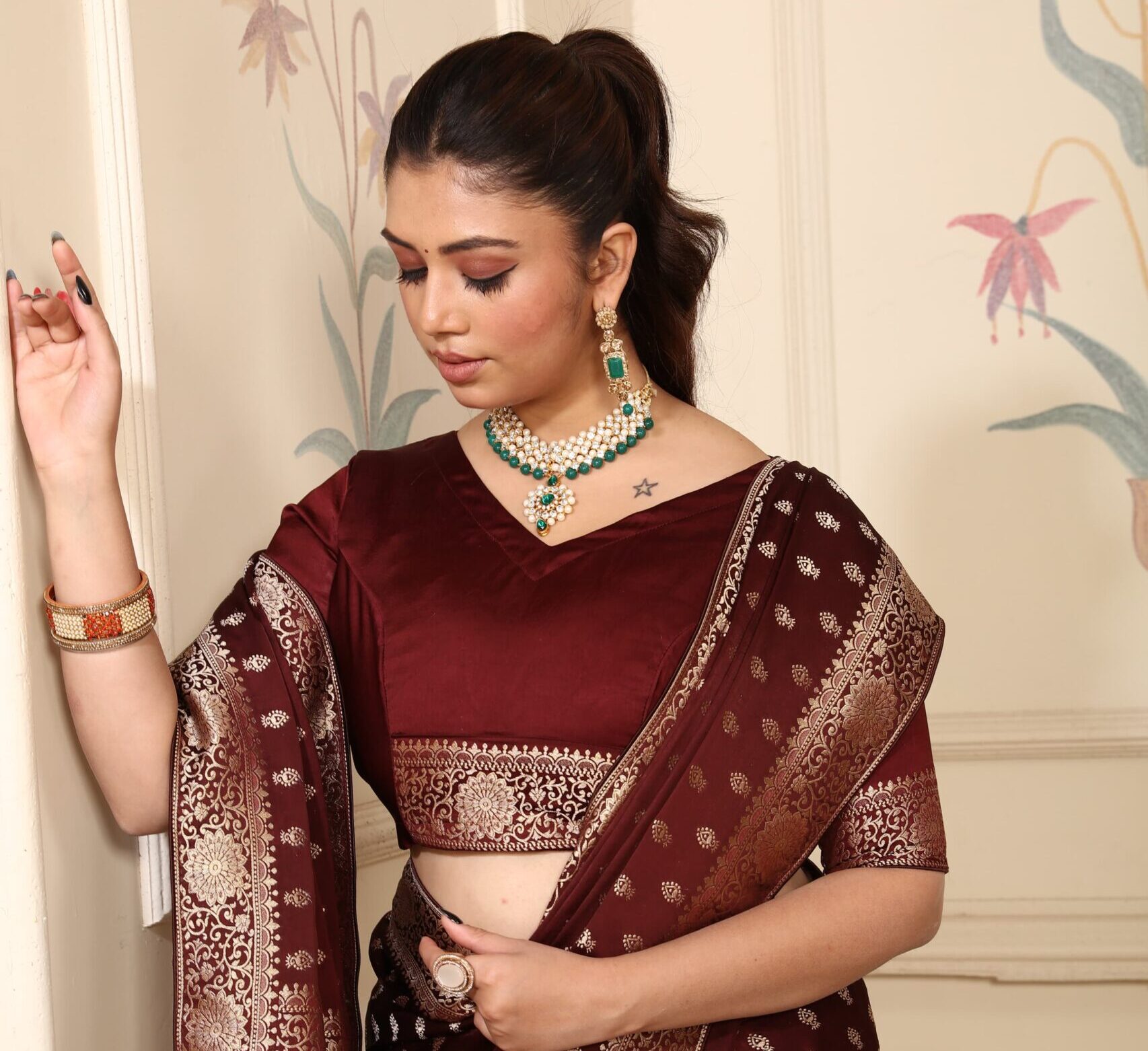The Timeless Elegance of Banarasi Silk Saree

The Timeless Elegance of Banarasi Silk Saree
When it comes to traditional Indian attire, few garments can rival the majestic allure of the Banarasi silk saree. Known for its intricate craftsmanship, rich history, and opulent fabrics, the Banarasi saree has long been a symbol of grace, culture, and luxury. Worn by brides, dignitaries, and celebrities alike, the Banarasi silk saree is an emblem of timeless beauty and a true testament to the artistry of Indian weavers.
A Glimpse into Its History

The origins of Banarasi silk sarees can be traced back to the holy city of Varanasi (Banaras), located on the banks of the River Ganges in Uttar Pradesh. The weaving tradition in this city dates back to over 5,000 years, influenced by Persian, Mughal, and Indian cultural exchanges. The city became famous for its fine silk, which was used to create luxurious garments for royalty and nobility.
The weaving techniques were brought to India during the Mughal Empire, and over centuries, the artistry has been refined to perfection. The Banarasi silk saree became synonymous with grandeur, often worn during weddings and religious ceremonies. To this day, these sarees are considered one of the finest and most sought-after types of silk sarees.
The Fabric: A Work of Art
The main attraction of a Banarasi silk saree lies in its luxurious fabric. The base material is typically pure silk that gives the saree a soft, smooth texture and a lustrous shine. What sets it apart, however, is the intricate weaving technique known as “jaal”, which involves weaving elaborate patterns into the fabric using gold or silver threads.
There are several types of Banarasi silk sarees, distinguished by their unique designs and weaving styles. These include:
- Kadhwa: The finest of all Banarasi weaves, where each motif is woven separately with a handloom, resulting in a crisp and clear pattern.
- Jangla: Known for its floral and foliage patterns, Jangla sarees have a more pronounced texture.
- Tanchoi: These sarees feature elaborate floral designs, woven with silk threads, and are more suitable for formal occasions.
- Vaskat: Often featuring geometric patterns and designs with intricate border work, Vaskat sarees are a blend of traditional and contemporary designs.
Designs and Motifs
Banarasi silk sarees are famous for their rich and diverse range of designs. The motifs often take inspiration from Mughal architecture, nature, and traditional Indian symbolism. Common motifs include:
- Floral patterns: Inspired by nature, intricate floral designs such as roses, lilies, and lotuses are often woven into the fabric.
- Paisley: The iconic paisley motif is a common feature, symbolizing prosperity and fertility.
- Temples and Palaces: Many sarees are adorned with designs inspired by the grandeur of Mughal palaces and temples, featuring arches, domes, and jharokhas (overhanging enclosed balcony).
- Zari work: Gold or silver threads are skillfully woven into the fabric to create a rich, ornate finish. This is often used for borders, pallus (the end part of the saree), and motifs.
Banarasi Silk Saree: A Symbol of Elegance and Tradition
One of the most iconic occasions to wear a Banarasi silk saree is during a wedding. The luxurious fabric and stunning embellishments make it the perfect choice for brides, with many opting for rich red, gold, or deep royal hues. However, these sarees are also suitable for festivals, poojas, and other celebratory occasions where a touch of opulence is needed.
The saree’s appeal is timeless, blending old-world charm with contemporary aesthetics. Even today, designers are giving the Banarasi silk saree a modern twist by incorporating different draping styles, contemporary patterns, and lighter fabrics, while still preserving the classic appeal.
How to Style a Banarasi Silk Saree
A Banarasi silk saree, with its majestic beauty, often requires minimal accessories. However, pairing it with the right jewelry and styling can elevate its charm. Here are a few tips:
- Jewelry: Opt for traditional gold jewelry—heavy chokers, jhumkas, and kadas are popular choices. Brides often wear intricate temple jewelry with their Banarasi sarees for a regal look.
- Hairstyle: A classic bun adorned with flowers or a sleek ponytail works well with the graceful folds of a Banarasi saree.
- Makeup: Keep your makeup subtle yet glamorous—think bold lips, smoky eyes, and a touch of highlighter to match the saree’s radiance.
- Footwear: A pair of traditional juttis or mojaris complements the look beautifully.
The Future of Banarasi Silk Sarees
With the growing global interest in sustainable and handcrafted fashion, Banarasi silk sarees are experiencing a resurgence. Many artisans are now blending traditional techniques with contemporary designs, offering a wider variety of colors, textures, and styles. The saree has also transcended regional boundaries, becoming a favorite among women across the world who seek to embrace Indian heritage and style.
Furthermore, efforts are being made to preserve the traditional weaving techniques of Banarasi sarees through various government and non-government initiatives, ensuring that future generations can continue to enjoy the beauty of these iconic garments.
In Conclusion
The Banarasi silk saree is more than just a piece of clothing—it’s a statement of culture, luxury, and craftsmanship. Whether it’s the intricacy of its designs, the richness of its fabric, or the history embedded in every weave, this saree continues to captivate hearts and inspire awe. A true masterpiece of Indian heritage, the Banarasi silk saree will forever hold its place as one of the most exquisite symbols of tradition and elegance in the world of fashion.
So, the next time you attend a wedding or festive celebration, don’t just wear a saree—wear a story. Wear a Banarasi silk saree, and let its beauty speak for itself.
- Share

